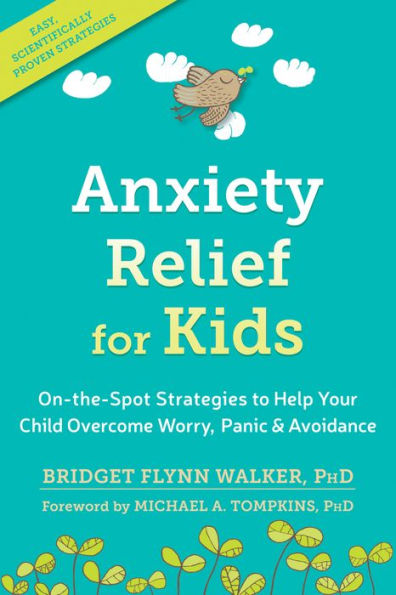“Bridget Flynn Walker has written a timely book. In our busy pediatric practice, we are seeing an increased number of children with anxiety these days. For parents and professionals alike, she clearly defines the different ‘faces’ of anxiety, and strategies that can be used to help our children and patients overcome them.” —Mary D. Piel, MD, pediatrician at Golden Gate Pediatrics in San Francisco, CA
“This book is a terrific resource for parents of anxious kids! Parents want to know what to do and what not to do to help their child with anxiety. Walker explains how trying to comfort your child can actually be feeding their anxiety. She offers up clear and powerful tools that parents can use with their child that will help them now and for the rest of their lives. —Jennifer Shannon, LMFT, author of The Anxiety Survival Guide for Teens
“With warmth and wisdom, this valuable book provides hope and empowerment to parents. Bridget Flynn Walker provides a clear and easily readable understanding of what makes anxiety worse, and scientifically-proven strategies for managing anxiety. Most importantly, she provides a practical road map that parents can follow to help their children become braver and more confident in tackling their fears.” —Aureen Pinto Wagner, PhD, director of The Anxiety Wellness Center in Cary, NC, and author of Worried No More
“Just what the doctor ordered! A clear, concise, and practical guide to help parents help their children master their anxieties. I am confronted with patients and their parents every day who are searching for guidance in managing their children’s omnipresent worries. The cognitive behavioral therapy (CBT) strategies outlined are easy to understand and straightforward to implement. This book provides a real-life tool kit that will help families and their physicians ease the fears that children often have.” —Laurel J. Schultz, MD, MPH, community pediatrician at Golden Gate Pediatrics, and volunteer associate clinical faculty at the University of California, San Francisco
“Bridget Flynn Walker’s book, Anxiety Relief for Kids, provides an invaluable resource for parents and mental health professionals to help children manage and overcome anxiety. The book’s approach is clear, concise, and informative. This step-by-step guide—full of evidence-based strategies to implement with children—uses easy-to-understand language, and offers vivid examples and helpful worksheets which make the book simple and effective to use.”—Anya Ho, PhD, clinical psychologist at the San Francisco Group for Evidence-Based Psychotherapy
“This book is a much-needed resource for parents of kids with anxiety. It outlines essential psychoeducation about anxiety, and how to tackle its treatment. This book can help empower parents towards addressing their kid’s anxiety and give them the essential tools needed to be successful.”—Natalie Todd, PsyD, clinical psychologist at the University of California, San Francisco, working with teens and young adults
“Bridget Flynn Walker’s book tackles a complex and vexing problem for so many families, providing simple and easy-to-learn methods that will ease your child’s anxiety and boost confidence. Anxiety Relief for Kids is a go-to resource for parents or anyone else trying to help a child with excessive anxiety. I recommend it highly.” —Eli Merritt, MD, founder of Merritt Mental Health
“This little gem of a book offers useful information for parents who are first learning about anxiety in their children. The book is highly approachable, and synthesizes much of the currently available information on child anxiety and evidence-based treatment strategies. Parents will particularly appreciate the friendly and unassuming language, and the real-life examples that bring many familiar dilemmas to life. The section on how not to ‘feed your child’s anxiety’ will be especially useful for parents wondering how to help their child feel less anxious without contributing to the kind of unhelpful avoidance that maintains the problem. Bridget Flynn Walker has a clear voice and a knack for explaining ideas so that they just make sense.”—Eli R. Lebowitz, PhD, associate director of the Anxiety and Mood Disorders Program, and assistant professor at the Yale Child Study Center
09/15/2017
Clinical psychologist Walker, PhD, whose skills are based in cognitive behavioral therapy (CBT), assists parents in taking a leading role in helping their elementary-aged child overcome anxiety, panic, and obsessions. The author begins by explaining that "children with anxiety disorders often function well in terms of grades, achievement, and more, yet live a tortured internal life rife with worry, fear, or excessive guilt or feelings of responsibility." Despite doomsday scenarios never coming to realization, children with anxiety are often unable to take away from the situation positive solutions and therefore must learn to identify negative thinking, work to change those thoughts, and then modify specific behaviors. VERDICT Although the sample dialog feels a bit staged, it does a good job of illustrating a parent's role. Those with the confidence and consistency to implement the practices introduced here will find Walker's approach useful.
★ 03/01/2018
Clinical psychologist Walker, PhD, whose skills are based in cognitive behavioral therapy (CBT), assists parents in taking a leading role in helping their elementary-aged child overcome anxiety, panic, and obsessions. The author begins by explaining that "children with anxiety disorders often function well in terms of grades, achievement, and more, yet live a tortured internal life rife with worry, fear, or excessive guilt or feelings of responsibility." Despite doomsday scenarios never coming to realization, children with anxiety are often unable to take away from the situation positive solutions and therefore must learn to identify negative thinking, work to change those thoughts, and then modify specific behaviors. VERDICT Although the sample dialogue feels a bit staged, it adeptly illustrates a parent's role. Those with the confidence and consistency to implement the practices introduced here will find Walker's approach useful.—Julia M. Reffner, Richmond, VA



